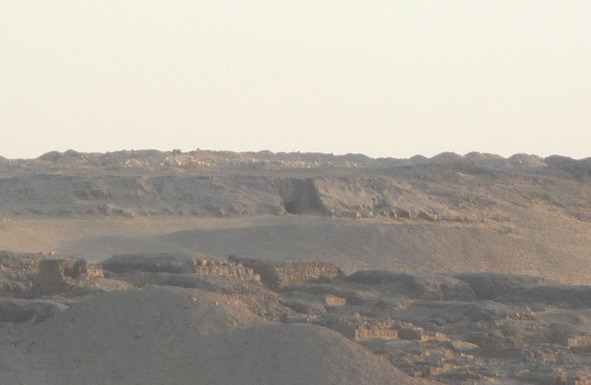UNDER INVESTIGATION
Egyptian archaeological team
move in to find answers

The entrance to the Tomb of the Birds (NC 2) visible in the Giza plateau's north
cliff, as seen close to sunset one day in April 2009 (pic credit: Andrew Collins, 2009
EGYPT'S
CAVE UNDERWORLD
UNDER INVESTIGATION
Egyptian
archaeological team
move in to find answers
The
entrance to the Tomb of the Birds (NC 2) visible in the Giza plateau's north
cliff,
as seen close to sunset one day in April 2009 (pic credit: Andrew Collins, 2009
Dr Zahi Hawass, Secretary General of Egypt's Supreme Council of Antiquities, is now exploring the Tomb of the Birds, the point of access to Giza's cave underworld discovered last year by Nigel Skinner Simpson, Sue Collins and myself. Coincidence? Note likely. He and his team have been in there ever since news of the discovery hit the internet in August. Obviously, I applaud his interest in our cave discoveries, but I remain cautious of his intentions. His official view will be that he has found Giza's lost bird and animal cemetery, long known to exist on the plateau but never traced until now. I suspect that this will be the official announcement next year. I might be wrong. Let's wait and see.
Yet strangely there is still no mention of the caves themselves. In an email to me last Friday he admits that the "system" is now being cleared, and that in his opinion it is merely a "catacomb", like so many others in Egypt.
This is wrong. Other catacombs in Egypt are rock cut by human hands. What we have found is a unique natural cave system that stretches beneath the plateau for hundreds of meters, and would seem to have been adapted in Egypt's Late Dynastic period to become a bird cemetery.
On December 2nd a press statement announcing Dr Hawass's investigations was issued. See:
http://www.responsesource.com/releases/rel_display.php?relid=mQQQQ
I can also announce that at least one person known to us has managed to run the gauntlet and get inside the Tomb of the Birds, snapping off several pictures before being caught and thrown out by guards. His photos, taken as far back as August, show that Dr Hawass's team have uncovered deep vertical shafts that are extensions of the T-shaped antechambers entered just inside the tomb's entrance. From these shafts stretch horizontal pits that go towards the south in both instances.
The
Cult of Which Bird?
It is likely that the in fill from both of these
shafts is revealing clues regarding the tomb's use as a bird cemetery, (the last
people known to have authorized the clearance of the site, uncovering evidence
of bird mummies in the process, was British explorer Col. Richard Howard Vyse
and his engineer friend John Shae Perring back in 1837).
To date we do not know what type of mummified birds were deposited as offerings in the tomb, no doubt in honour of a local bird deity.
If they were raptors, i.e. falcons, hawks, etc., then the cult was probably that of Sokar, the patron of Giza in its capacity as Rostau, the Duat or underworld of Memphis (some might conclude it was Horus, a hawk god associated with the Sphinx in New Kingdom times, but this seems unlikely to me).
If they were ibises, then the cult was that of Thoth-Hermes, whose cave-tomb was said to be the Second Pyramid, a belief held true by the Sabaeans of Harran SE Turkey, who came regularly to Giza on pilgrimages to venerate the Great and Second Pyramid, as well as the Sphinx monument.
So what will it be raptors, or ibises? Since we now suspect that the caves stretch right beneath the Second Pyramid, then the second opinion is becoming ever more likely. In other words, the Tomb of the Birds was seen as an entrance to the Tomb of Hermes.
We shall keep you updated on developments, because we know you are interested.